
Daily Dose Of Jazz…
Lawrence Brown was born on August 3, 1907 on August 3, 1907 in Lawrence, Kansas. When he was about six or seven years old his family moved to Oakland, California. He began playing the violin at a young age, but quickly grew tired of it and turned to playing the tuba in his school’s band.
Coming from a musical background, his mother played the organ and the piano and he often sang as a part of his father’s sermons when he preached at the A. M. E. Church. Brown discovered the trombone while doing janitorial work at his father’s church and wanted to replicate the sound of cello on a trombone.
Beginning his career with Charlie Echols and Paul Howard, in 1932 he joined Duke Ellington’s band. He was featured with the band every year on compositions such as Blue Cellophane and Golden Cress. Leaving Ellington’s band in 1951, Lawrence joined Johnny Hodge’s band, where he stayed for four years. After this stint he took a five year position as a session player with CBS.
He rejoined Ellington in 1960 and stayed with him until 1970. After leaving Ellington’s band the second time at the age of 63, Brown stopped performing.
Trombonist Lawrence Brown, whose fast technical style inspired trombonists from Tommy Dorsey to Bill Harris, died on September 5, 1988 in Los Angeles, California, at the age of 81.
More Posts: history,instrumental,jazz,music,trombone

Daily Dose Of Jazz…
Charlie Queener was born in Pineville, Kentucky on July 27, 1921 or 1923, the actual year of his birth is in question. During the Forties he worked with the Muggsy Spanier Orchestra, Harry James Orchestra, Benny Goodman Orchestra, Joe Marsala Orchestra, and Glen Gray among others.
Between 1946-50 Queener settled into Nick’s in New York and then spent much of his career freelancing with Dixieland all-stars. Among his associations were Bobby Hackett, Billy Butterfield, Jimmy McPartland, Ruby Braff, Max Kaminsky, Wingy Manone from 1954 to 1960, Wild Bill Davison and with Clarence Hutchenrider on and off from 1958 to 1973, to name a few.
He worked into the 1990s, also composed orchestral works starting in the mid-1960s but never led a record session of his own. Pianist Charlie Queener, who played in Dixieland, swing and mainstream settings, died in July 1997.
More Posts: history,instrumental,jazz,music,piano

Daily Dose Of Jazz…
Mary Osborne was born in Minot, North Dakota on July 17, 1921 into a musical family. As early as age three she showed an interest in music with her earliest instruments including piano, ukulele, violin, and banjo. At nine, she picked up the guitar. At ten, she started playing banjo in her father’s ragtime band. She was featured on her own radio program, performing twice weekly until she was fifteen. At twelve she started her own trio of girls to perform country music in Bismarck, North Dakota.
By the time she turned fifteen, Osborne joined a trio led by pianist Winifred McDonnell, for which she played guitar, double bass, and sang. After hearing Charlie Christian play electric guitar she immediately bought her own electric guitar and had a friend build an amplifier. She sat in with Christian to learn his style of guitar. Her husband and trumpeter Ralph Scaffidi encouraged her musical career.
The early 1940s saw Mary sitting in on jam sessions on 52nd Street, on the road with jazz violinist Joe Venuti and working freelance in Chicago, Illinois when she made a recording with Stuff Smith. In 1945, Osborne headlined a performance with Dizzy Gillespie, Art Tatum, Coleman Hawkins, and Thelonious Monk in Philadelphia, Pennsylvania to reviews and audiences that praised her specifically. She, Tatum, and Hawkins went on to record a concert in New Orleans.
Returning to New York City she recorded with Mary Lou Williams in 1945, Coleman Hawkins, Mercer Ellington, and Beryl Booker in 1946, and led her own swing trio. For three years her trio played 52nd street clubs, had a year-long engagement at Kelly’s Stables, and made several recordings. Throughout the 1950s, she played with Elliot Lawrence’s Quartet on The Jack Sterling Show, and appeared on the television show Arthur Godfrey’s Talent Scouts.
By the Sixties her focus changed to learning Spanish classical guitar under Alberto Valdez-Blaine and incorporated pick-less playing into her jazz playing. Osborne moved to Bakersfield, California, where she lived the rest of her life, and founded the Osborne Guitar Company with her husband. Mary taught music and continued to play jazz locally and in Los Angeles, California as well as several jazz festivals over the next two decades.
Guitarist Mary Osborne died on March 4, 1992 at the age of 70, the result of chronic leukemia.
More Posts: bandleader,guitar,history,instrumental,jazz,music

Daily Dose Of Jazz…
Erik Parker was born July 13, 1918 in Århus, Denmark. By 1938 he became a member of the Svend Asmussen Orchestra and from 1939 to 1945 was involved in Leo Mathisen’s Orchestra, where he performed both as an instrumentalist and a vocalist.
He worked as a club manager, and from 1945-1951 he was an actor. In 1953 he emigrated to the United States, where he settled in Los Angeles, California where he became a restaurateur and trumpet teacher.
Throughout his career he was a member of the All Danish Starband, Henry Hagemann & His Full Brass, Henry Hagemann’s Sextet, Kai Ewans And His Swinging 16, Leo Mathisens Band, Leo Mathisens Orkester, Leo Mathisens Ønskeorkester, and Roger Henrichsen Trio.
Trumpeter and vocalist Erik Parker, who is considered one of the most significant Danish jazz musicians and a distinguished representative of golden age jazz, died in 2003.

Daily Dose Of Jazz…
Lembit Saarsalu was born July 8, 1948 in Roosna-Alliku, Estonia. He started playing jazz at an early age. He debuted at the Tallinn International Jazz Festival at the age of 16. He worked for many years in the State Philharmonic of the Estonian SSR , where as a paid musician he gave numerous concerts both at home and abroad. In the 1980s, Saarsalu devoted himself completely to jazz.
For decades, he has led local and international ensembles. He worked in a duo with Leonid Vintskevich, started a new international jazz festival Rainbow Jazz with music producer Merle Kollom and a competition for young musicians in Tartu.
As an educator Saarsalu introduced jazz in schools and has performed together with Olav Ehala and other well-known Estonian musicians for more than 40,000 students. Since the fall of 2016, he has been working as a saxophone and ensemble teacher in the rhythm music department of the Tartu Music School.
In the 1980s Eesti Televisioon made two films about Lembit, he has performed on Finnish and Spanish television and has made numerous recordings, numbering 200 recordings for Estonian Radio. His style ranges from blues and swing to free forms of jazz.
He has been repeatedly chosen as the best tenor saxophonist, awarded the annual prize of the Sound Art Endowment Fund of the Estonian Cultural Capital.
Saxophonist , bandleader and composer Lembit Saarsalu, who has been called the saxophone king and the calling card of Estonian jazz, continues to perform, compose and teach.
More Posts: bandleader,composer,history,instrumental,jazz,music,saxophone



